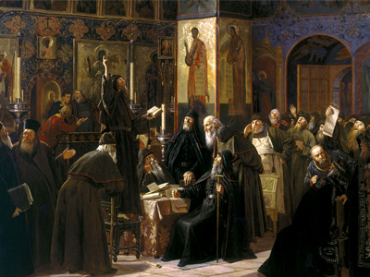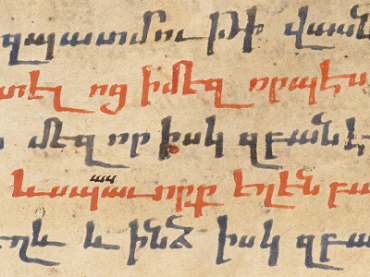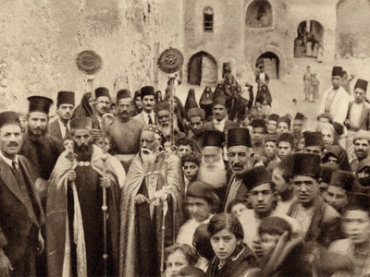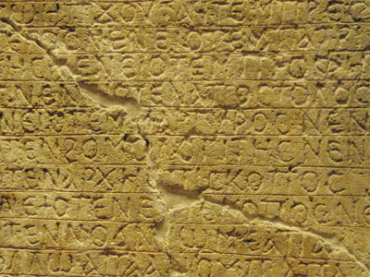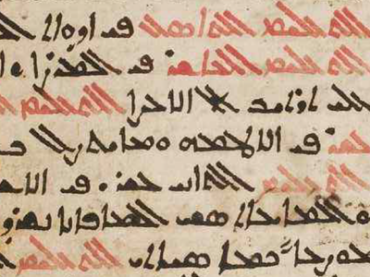Syriac and Eastern Christianity
Le texte grec des récits du moine Anastase sur les saints pères du Sinaï
Edited with an Introduction by François Nau
Series: Analecta Gorgiana 402
ISBN: 978-1-60724-676-3
François Nau collated various manuscripts containing stories about the holy fathers of Sinai and presents here the critical and annotated text. These stories offer otherwise unknown information about St. John Climacus and include useful historical and geographic details.
$37.00
Eine syrische "Liturgie S. Athanasii"
Edited with an Introduction by Anton Baumstark
Series: Analecta Gorgiana 403
ISBN: 978-1-60724-677-0
This Syriac version of the “Liturgy of St. Athanasius” provides a valuable resource for the development of liturgical materials and practices in the Syrian Monophysite tradition. The text includes a critical apparatus and a Latin translation.
$39.00
Zwei Synoden des Katholikos Timotheos I
Edited with an Introduction by Oskar Braun
Series: Analecta Gorgiana 404
ISBN: 978-1-60724-678-7
The records of two provincial synods found among the writings of Catholicos Timothy I provide a unique perspective into the christological disputes and struggle for authority in Syriac-speaking Christianity in the late 8th century.
$36.00
Abû-l-Barakats nichtgriechisches Verzeichnis der 70 Jünger
Edited with an Introduction by Anton Baumstark
Series: Analecta Gorgiana 405
ISBN: 978-1-60724-680-0
Abu-al-Barakat published two versions of the list of seventy disciples sent out by Jesus. Anton Baumstark presents here the Arabic text, along with a Latin translation, of Barakat’s list that was allegedly translated a non-Greek source.
$38.00
Abû-l-Barakats "griechisches" Verzeichnis der 70 Jünger
Edited with an Introduction by Anton Baumstark
Series: Analecta Gorgiana 406
ISBN: 978-1-60724-681-7
Abu-al-Barakat published two versions of the list of seventy disciples sent out by Jesus. Anton Baumstark presents here the Arabic text, along with a critical Latin version, of Barakat’s list that was allegedly translated from a Greek original.
$37.00
Le texte grec des récits utiles à l'âme d'Anastase (le Sinaïte)
Edited with an Introduction by François Nau
Series: Analecta Gorgiana 407
ISBN: 978-1-60724-682-4
These eighteen stories pertaining to Anastasius of Mount Sinai include unique information and variations of stories preserved elsewhere. Nau presents the edited Greek text along with an introductory discussion of authorship and sources.
$38.00
Die armenischen apokryphen Apostelakten II. Die Akten der Apostel Petrus und Paulus
Edited with an Introduction by Paul Vetter
Series: Analecta Gorgiana 408
ISBN: 978-1-60724-683-1
Paul Vetter presents here a critical edition of the Armenian version of the Acts of Peter and Paul along with a Greek translation. Vetter’s introduction to the text includes a discussion of the complex transmission history evident in the manuscripts.
$53.00
Une nouvelle récension de la vie d'Abercius
Edited with an Introduction by Élie Batareikh
Series: Analecta Gorgiana 409
ISBN: 978-1-60724-684-8
The Life of Abercius, which received much attention after the archaeological discovery of the “inscription of Abercius,” previously existed in two recensions. Élie Batareikh found a manuscript containing a third recension and publishes here the Greek text of that recension.
$37.00
My Tour in the Parishes of the Syrian Church in Syria and Lebanon
By Abrohom Nuro
Series: Abrohom Nuro Library 4
ISBN: 978-1-60724-685-5
A record of the author’s investigation concerning the situation of the Syriac-speaking churches during the 1960s. The author provides statistics about parishes, schools, organizations, and cultural activities. The book lists most of the educational institutions with hundreds of photographs, as well as biographies and photos of Syriac writers and Orientalists specializing in Syriac studies.
$208.00
Jewish-Christian Conversation in Fourth-Century Persian Mesopotamia
A Reconstructed Conversation
Series: Judaism in Context 12
ISBN: 978-1-4632-0156-2
Was there an active Jewish-Christian polemic in fourth-century Persia? Aphrahat’s Demonstrations, a fourth-century adversus Judaeos text, clearly indicates that fourth-century Persian Christians were interested in the debate. Is there evidence of this polemic in the rabbinic literature? Despite the lack of a comparable Jewish or rabbinic adversus Christianos literature, there is evidence, both from Aphrahat and the Rabbis that this polemic was not one sided.
$169.00
Journal of the Canadian Society for Syriac Studies 9
Edited by Amir Harrak
ISBN: 978-1-60724-686-2
Volume 9 includes articles by Alexander Treiger, Mark Dickens, Emmanuel Joseph Mar-Emmanuel, Khalid Dinno and Amir Harrak, and Martin Tamcke.
$75.00
Die nichtgriechischen Paralleltexte zum achten Buche der Apostolischen Konstitutionen
Series: Analecta Gorgiana 410
ISBN: 978-1-60724-687-9
Book VIII of the Apostolic Constitutions has one of the most complex transmission histories of any text from the Christian Orient. Anton Baumstark describes various sources for parallel texts in order to explicate its translation history in the Oriental languages.
$39.00
Die armenischen apokryphen Apostelakten I. Das gnostische martyrium Petri
Edited with an Introduction by Paul Vetter
Series: Analecta Gorgiana 411
ISBN: 978-1-60724-688-6
Paul Vetter presents the Armenian text, along with a Greek translation, of the “Gnostic Martyrdom of Peter” from the Apocryphal Acts of the Apostles. The article also includes an appendix in which Vetter describes the manuscripts used in the collation.
$35.00
Der Katholikos Timotheos I und seine Briefe
Translation and Introduction by Oskar Braun
Series: Analecta Gorgiana 412
ISBN: 978-1-60724-689-3
Oskar Braun provides a brief introduction to the life and career of Patriarch Timothy I, including a list of his writings with special attention to his letters and the Syriac text and German translation for five of Timothy’s letters.
$44.00
Die Evangelienexegese der syrischen Monophysiten
Series: Analecta Gorgiana 413
ISBN: 978-1-60724-690-9
Anton Baumstark presents a historical survey of the development of the exegetical methods of the Syriac Orthodox (“Jacobite/Monophysite”) tradition. Baumstark conducts this survey by detailing the influence of various exegetical works through three distinct historical periods.
$41.00
Eine syrische "traditio legis" und ihre Parallelen
Series: Analecta Gorgiana 414
ISBN: 978-1-60724-691-6
Early Christian artistic renderings of the traditio legis, exhibit a variety of commonalities and differences. Anton Baumstark compares various versions of the scene and finds evidence of both a Western and an Eastern version represented in multiple sources.
$36.00
"Ligurgia S. Gregorii Magni," eine griechische Uebersetzung der römischen Messe
Edited with an Introduction by Anton Baumstark
Series: Analecta Gorgiana 415
ISBN: 978-1-60724-692-3
Anton Baumstark presents the complete Greek text of the Liturgy of Saint Gregory the Great. The liturgy was highly influential in the Latin tradition, but as evidenced by the early translation, it also had limited circulation in the Greek tradition.
$36.00
Die anonyme Schrift "Abhandlung über den Glauben der Syrer"
Edited with an Introduction by Franz Cöln
Series: Analecta Gorgiana 416
ISBN: 978-1-60724-693-0
Franz Cöln presents here the Arabic text of an anonymous writing defending the beliefs of the Jacobite Church against the beliefs of other traditions. The text includes a critical apparatus and is accompanied by a German translation.
$46.00
Zwei antihäresianische Traktate des Melchiten Paulus er-Râhib
Translation and Introduction by Joseph Berenbach
Series: Analecta Gorgiana 417
ISBN: 978-1-60724-694-7
Joseph Berenbach presents here the Arabic text and German translation of an important anti-heretical work by the Melkite Christian author Paul er-Rahib. Berenbach describes the manuscripts used in the critical text and introduces the character of Paul.
$38.00
Chronicle of the Unknown Edessan
Translated into Arabic by Albert Abouna
Series: Abrohom Nuro Library 5
ISBN: 978-1-60724-695-4
The Syriac Chronicle of the Unknown Edessan (Chronicle of 1234) is an important resource for the period stretching from early Islam until the Crusades. The original manuscript, dating from the fourteenth century, was discovered by Patriarch Afram II Rahmani in Istanbul in 1899. The Syriac text was published by Chabot in collaboration with Afram Barsoum (later Patriarch Afram I Barsoum). The chronicle consists of two parts: Part I covers early world history, while Part II covers early Islam and is an eyewitness account of the Crusades. In this edition, Albert Abouna provides an Arabic translation of Part II with annotations. The volume includes comprehensive indices of names and places.
$189.00
Jacobus Baradaeüs, de stichter der syrische monophysietische kerk
Series: Syriac Studies Library 9
ISBN: 978-1-60724-783-8
In this study, H. G. Kleyn deals with the life and works of Jacob Baradaeus and the role he played in the “monophysite” church to the time of his death in 578, including a thorough outline of Jacob’s writings.
$168.00
Syrisch-arabische Glossen
Erster Band: Autographie einter Gothaische Handschrift enthaltend Bar Ali's Lexikon von Alif bis Mim
Edited with an Introduction by Georg Hoffmann
Series: Syriac Studies Library 10
ISBN: 978-1-60724-784-5
The ninth-century Syriac-Arabic lexicon of Bar Ali stands with Bar Bahlul’s as a main witness to contemporary Syriac lexicography. Hoffmann presents the first half of the work—the second was edited by Gottheil—with a critical apparatus.
$181.00
Ein nestorianisches Bruchstück zur Kirchengeschichte des 4 und 5 Jahrhunderts
Edited with an Introduction by Emil Goeller
Series: Analecta Gorgiana 418
ISBN: 978-1-60724-709-8
Emil Goeller introduces and provides the text of a unique resource for the ecclesiastical history of the “Nestorian” church. The text, presented in Syriac with a Latin translation, is a compilation of historical sources focused on the story of Nestorius.
$36.00
Zwei syrische Dichtungen auf das Entschlafen der allerseligsten Jungfrau
Edited and Translated by Anton Baumstark
Series: Analecta Gorgiana 419
ISBN: 978-1-60724-710-4
Anton Baumstark publishes two memre on the subject of Mary’s passing. The first is attributed to Jacob of Serug and the second to John of Birta. Baumstark also provides a brief introduction to the texts.
$40.00
Frühchristlich-syrische Psalterillustration in einer byzantinischen Abkürzung
Series: Analecta Gorgiana 420
ISBN: 978-1-60724-711-1
Anton Baumstark describes thirty Psalter illustrations that he found in a manuscript belonging to the Greek Patriarch of Jerusalem. These illustrations significantly increase our knowledge of Psalter illustrations in the Syriac tradition.
$36.00
Filter by
Filter by price
Filter by manufacturer


